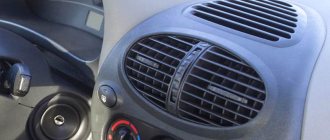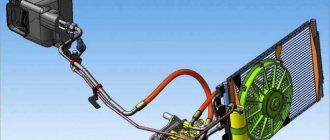Rated fuel consumption is one of the most informative and important characteristics of a car for the driver. This is what manufacturers often use to advertise and promote a particular new car model.
Among owners of used cars, it is considered acceptable to consume up to 10 liters of gasoline or diesel per 100 kilometers. In foreign countries, this indicator is indicated in miles, so recalculation into “native” units is often necessary. The fuel consumption tables available in this section of the site are considered very useful.
What does the fuel consumption indicator indicate? What does this characteristic mean? We are talking about hydrocarbon fuel consumption. For example, for an SUV the figure corresponds to 9.5 liters per 100 km. It is quite acceptable, primarily due to the weight and power of the car. The indicator can be reduced due to the following:
- use of energy recovery systems during braking;
- lightening the weight of the car when replacing body and chassis elements with innovative materials;
- engine improvements;
- replacing the exhaust system.
For new models, consumption of 6 l/100 km is considered quite a “cruising” figure, but it will be higher for heavy SUVs and pickups and lower for small hybrids. The necessary information can be found in the tables provided.
What to do if fuel consumption is higher than rated? If the car consumes more fuel and does not correspond to the nominal value indicated in the table, this means there is a malfunction. Experienced service center technicians will tell you how serious it is and how it can be eliminated. In some cases, tuning makes it possible to further optimize fuel consumption, but this is usually achieved by lightening the body structure or by replacing the engine. Professional automotive technicians can provide specific recommendations.
Fuel consumption of Lada Kalina ranges from 6.7 to 7.8 liters per 100 km.
Lada Kalina is available with the following types of fuel: Gasoline AI-95.
Conversion of Kalina hatchback from gasoline to gas Gas consumption of VAZ Kalina 2 after installing LPG
Based on the gasoline consumption data for 3 trim levels of Kalina 2, we calculate gas consumption. Let's calculate how much cheaper gas filling is. How many kilometers will Kalina travel without refueling?
Let's see how much gasoline in liters per hundred kilometers is consumed by 3 types of VAZ Kalina II engines from 2013 to the present day, which are equipped with 5-door hatchbacks. Data for other Kalina bodies:
Gasoline costs
| Volume | Transfers | Gasoline type | Gasoline consumption by road type | Price of 1000 km of gasoline, mixed mode | ||
| In the city | On the road | Mixed | ||||
| 1.6 | Mechanics | 95 | 8.6 | 5.6 | 6.7 | |
| 1.6 | Robot | 95 | 8.6 | 5.6 | 6.7 | |
| 1.6 | Machine | 95 | 10.4 | 6.1 | 7.7 | |
| Consumption in liters per 100 km. Gasoline price in rubles per liter: 95 - 47.00 rubles. | ||||||
How to reduce consumption
Aggressive driving style and unreasonable acceleration on busy sections of the road lead to increased costs; driving on the highway at the maximum speed for a car also causes unnecessary losses. The car reacts sensitively to the slightest movement of the accelerator pedal, and the kick-down mode responds almost instantly; the electronics promptly shift the gear to a lower gear and crank the engine up to maximum speed, after which it moves to the next stage.
First generation: Lada kalina 2 16 l 16v 106 hp
The more owners add their data on the real fuel consumption of their car, the more accurate the information obtained about the true fuel consumption of a particular car will be. The engine is quite dynamic, but performs better at high speeds, which affects its fuel economy; it is not inferior to its 1.
Propane consumption, savings
| Volume | Transfers | Gas type | Gas consumption by road type | Refueling for 1000 km, mixed mode | ||||
| In the city | On the road | Mixed | Petrol | Gas | Difference | |||
| 1.6 | Mechanics | CIS | 9.5 | 6.2 | 7.4 | 3 149 ₽ | 1 628 ₽ | |
| 1.6 | Robot | CIS | 9.5 | 6.2 | 7.4 | 3 149 ₽ | 1 628 ₽ | |
| 1.6 | Machine | CIS | 11.4 | 6.7 | 8.5 | 3 619 ₽ | 1 870 ₽ | |
| LPG - liquefied petroleum gas (propane). Gas price in rubles per liter: CIS - 22.00 rubles. | ||||||||
Vehicle characteristics
Auto parameters
Since 2000, AvtoVAZ has moved to a higher level of its activities. Active, energetic, enterprising people, full of new plans and projects, become leaders. In 2007, the first generation Lada Kalina went on sale, which became a milestone in the plant’s work. Left behind is excessive domestic simplicity, characteristic of the USSR, but unacceptable for the new Russia. In order for the company's products to fully comply with the greatly changed requirements and standards, a major restructuring of the entire work process was carried out: additional buildings were built, modern equipment of both domestic and Western production was purchased, and personnel were retrained. Today, training events are included in the main activity plan of the plant.
However, the first generation of Kalina was not entirely successful: there were numerous technical flaws. But at the same time, Lada had an attractive appearance, which compared it with its analogues - Volkswagen and Renault. There were equal numbers of pros and cons. The management decided not to abandon the idea and continued working on the project.
In March 2013, an updated, modernized, completely redesigned version appeared - already the second generation of Lada. The engineers took into account the drivers' dissatisfaction with the first version of the car, made serious adjustments on all issues, and worked a lot on the appearance so that it acquired dynamic features. In addition, Lada received a new transmission and automatic transmission.
The car has become much more stable and reliable, safer and more practical, as evidenced by positive reviews from owners of the second generation Lada Kalina.
Real fuel consumption of Lada Kalina 1.6 16V. Engine capacity 16
| What is the fuel consumption on Kalina 2 automatic. How much gasoline does Lada Kalina consume - passport and real data This sad moment worsened three years after purchase, the injector with nozzles became clogged, for some reason this happens more often on the 8-valve Kalina than on other engines. The sedan has a closed body, with 2-3 rows of seats for the driver and passengers, the trunk is separated from the car interior, there is no lifting door in the rear wall; |
- From Red Square to the Moscow Ring Road and back in Moscow 50 km. How much gas does one save per month of such trips?
- From Moscow to Sochi - 1600 km. How much cheaper will it be to fill up with gas?
Reviews about fuel consumption of Lada Kalina 1.4 16V per 100 km • Kalina's consumption per 100 km is about 11-12 liters in the city, but maybe a little less on the highway, I didn't measure it.
DIY replacement
If necessary, you can replace the automatic transmission yourself. To do this, you will need to stock up on the necessary tools, as well as purchase a new gearbox.
The sequence of actions for self-replacement is presented below:
- First of all, you will need to disconnect the terminals from the battery and open the hood completely.
- Next will be dismantling the oil filler cap. In addition, it is necessary to remove the damaged gearbox, loosen the fixing clamp and disconnect the sensors connected to it. You will also need to disconnect the intake pipe hose.
- The final action will be to replace the automatic transmission by installing the unit in place of the one that was dismantled. Additionally, lubricant is applied to the surface of the gearbox to increase the life of the parts included in the structure, and the front part of the car is reassembled in the reverse order.
Lada Kalina 1st generation 8-valve
The base engine for Lada Kalina is a 4-cylinder naturally aspirated petrol engine VAZ-21114 with in-line cylinders and 8 valves. With a volume of 1.6 liters, it is capable of developing a power of 81 hp. and a torque of 120 Nm. This engine is paired exclusively with a traditional 5-speed manual transmission.
- Anton, Krasnodar. I drove a Subaru until the engine blew. There was no money for repairs (and the amount was very large), so I managed to exchange my Japanese car for the domestic auto industry in the form of a 2002 Lada Kalina with a 1.6 liter eight-valve engine. Everything turned out to be not as sad as I thought, but the consumption is a bit high - on the highway 8 liters, in the city - up to 12.
- Sergey, Kirov. When purchasing, I was focusing on a car in the price range of up to 200 thousand. It is clear that for that kind of money only the domestic auto industry is available, and you need to look carefully. In general, I found a good version of Kalina with a 1.6 eight-cylinder engine. The equipment is of course the simplest - but I’d rather have a lively body and suspension than a Conder in the car. Consumption is normal - the engine does not consume oil, on the highway it is about 7 liters, in the city - no more than 10.
- Semyon, Pyatigorsk. I was choosing between Granta and Kalina - the choice turned out to be in favor of the latter, since it was cheaper. Of course, if you get to know each other better, the domestic assembly and “high quality” are clearly visible, but at that price only the Chinese are available, and repairing them is a hemorrhoid. It would be possible to buy a used foreign car, but spare parts for them are not easy to get here, but for VAZs they are like dirt. In general, I chose the best from the worst. In terms of consumption - on a serpentine it turns out to be at least ten per hundred in mixed mode - another confirmation of the fact that “we choose the best from the worst.”
- Kostya, Volgograd. At the time of purchase, I had an amount of 300 thousand rubles - this is 2012. Among foreign cars for that kind of money - only slag. The only acceptable options are Lada Kalina or Granta, but it’s their turn for six months. As a result, I bought a Kalina hatch with an eight-valve engine. Consumption is low (like after the VAZ-2105) - 10 in the city, 8 on the highway. But the build quality is frankly g..o.
- Alexander, Kurgan. When the question arose in 2010 about buying a car, there were the following requirements: a manual transmission, high ground clearance (well, more or less), comfortable geometry with small overhangs, and a maximum of a couple of years after release. Result - Lada Kalina sedan 2008, eight-valve engine, plus Conder, engine heating and wheels. I drive carefully, so my consumption in the city is no more than 8.5 liters. At long range it comes out to about 6, maybe a little more.
Other cars: VAZ-2110 fuel consumption reviews
DIY replacement
If necessary, you can replace the automatic transmission yourself. To do this, you will need to stock up on the necessary tools, as well as purchase a new gearbox.
The sequence of actions for self-replacement is presented below:
- First of all, you will need to disconnect the terminals from the battery and open the hood completely.
- Next will be dismantling the oil filler cap. In addition, it is necessary to remove the damaged gearbox, loosen the fixing clamp and disconnect the sensors connected to it. You will also need to disconnect the intake pipe hose.
- The final action will be to replace the automatic transmission by installing the unit in place of the one that was dismantled. Additionally, lubricant is applied to the surface of the gearbox to increase the life of the parts included in the structure, and the front part of the car is reassembled in the reverse order.
As a rule, the cost of automatic transmission repair in Lada Kalina depends on what type of work will be carried out: partial or major. Undoubtedly, it is more profitable to repair a gearbox, since a new or used gearbox costs a lot of money.
Thus, the cost of a used automatic transmission varies from 30,000 to 50,000 rubles (taking into account delivery distance, etc.). The price of a new automatic transmission for the Lada Kalina ranges from 70,000-90,000 rubles.
Gasoline consumption per 100 km Lada Kalina 2 1.6 8 valves. Reviews: Engine capacity 16
| The average consumption of viburnum is 2 lux. How much gasoline does Lada Kalina consume - passport and real data. What does the average fuel consumption depend on? Sport is a sports version, which is equipped with a number of special parts: a bumper, an exhaust pipe tip, sports pedal pads, alloy wheels, a SAAZ Sport sports suspension, front and rear disc brakes, and an original reinforced gearbox. Of course, if you get to know each other better, the domestic assembly and high quality are clearly visible, but for such a price only the Chinese, and their repair is a hemorrhoid. |
- Maxim Orenburg. The purchase of Kalina was, one might say, accidental - initially I was considering exclusively foreign cars, but there was nothing in the range of 250-300 thousand. Sedan body, 1.4 liter 16 valve engine, manual transmission, year of manufacture - 2011. In principle, everything is fine - minor problems do not count. I often drive in highway-city mode, so I calculate the consumption as follows - it comes out to 6.8 l/100 km.
- Boris, Ust-Ordynsky. The car was needed for work, and the budget was strictly limited. I chose Kalina station wagon, produced in 2008 with a mileage of 43 thousand and a 1.4 liter engine. It was possible to take an eight-valve one, but I wanted a better package, since I do a lot of long-distance driving. Consumption on the highway is about 6 liters, no more, in the city about 2 liters more.
- Evgeniy, Tolyatti. At first I was looking for a Kalina with a Priorov 16-valve engine, but I couldn’t find any offers for the money I had. An option with a 1.4-liter engine turned up - good equipment, mileage only 20 thousand and one owner. I took it. In the city in winter it comes out to about 10 liters; I rarely drive on the highway, so I can’t say for sure.
- Fedor, Surgut. Kalina is my first car, because... I received my license only in 2013. But since my wife had them before, we got the car back in 2010. As for the engine, it’s a fairly economical engine, on average we get 9 liters per hundred square meters, but if you turn on the Conder, you really feel the dips and normal thrust generally only appears above 2500 rpm.
Lada Kalina 1.4 l 1st generation • The number of valves for Lada Kalina is 8 and 16.
The notorious human factor
On the highway the consumption is
7.6-7.8 l/100 km. In the city it is 7.9. I fill up with 92 gasoline, the transmission is manual, the engine is 98 l. air conditioning is on. About 18 l. This is kind of absurd.
Drivers who are not far from mechanics and the basics of economics understand perfectly well that the best way to save money is to eliminate the possibility of unnecessary spending. If the factory engine does not show the most favorable performance, then it makes sense to tune it and thereby bring it to perfection.
The least that can be done, and where you can start, if your car is a Lada Kalina, and you do not have significant capital, is replacing the spark plugs. Malfunctioning spark plugs increases fuel consumption by ten percent! The most suitable choice for you will be BOSH WR 78 X spark plugs. They will help with more efficient engine starting in winter (and we have already seen that it is in winter that the greatest fuel consumption occurs), and will also make its operation smoother.
The most you can do is to replace the standard engine with something more powerful, which would provide greater efficiency for the same cost of gasoline. This could be an engine of the same volume, but with 16 valves. Also, engine power increases when replacing the filter with a similar one with zero resistance.
Thus, it is easy to understand that fuel consumption primarily depends directly on the driver: if you carry out all the necessary modernization projects and fill the car only with high-quality gasoline, you can really reduce its consumption to a minimum.
Gearbox and features of the first generation
For the second generation, factory standards differ from real indicators, and they have increased compared to the first. The average city consumption is 11.4 liters, but on the highway it is almost 9 liters. Thus, it turns out that the average consumption will be almost 10 liters, which is significantly more than indicated in the service documents.
Real fuel consumption Lada Kalina 1.6 16V
- Yuri, Novosibirsk. I bought the car in winter 2011, immediately after receiving my license. Naturally, I chose the most budget option up to 300 thousand. Foreign cars don’t count - for that kind of money they’re generally miserable. I actually wanted to take Grant, but I didn’t want to wait, so I decided to buy a Kalina station wagon with the most powerful engine. At first I was simply amazed at the consumption - it was about 20 liters in the city in winter, but after running it in, the consumption dropped greatly and became no more than 10-12 liters in winter and up to 10 in summer. On the highway 4.8 - 5.5 liters per hundred square meters.
- Sergey, Novorossiysk. I considered Kalina only with a sixteen-valve valve, which I know from the VAZ-2112. It is torquey, quite resourceful and economical. Since there is an on-board computer, it is possible to find out the consumption without manually calculating it, but according to the readings. So, in the city on average I have from 7.1 to 8.6 liters, and on the highway - 4.8 - 5.0 liters.
- Fedor, Kostroma. I used to own a “Seven”, after selling it I managed to save up a little and started thinking about buying a new car. We only considered the VAZ - there was only enough money for a new one, and the devil is not as scary as everyone paints him to be. For the price it's an excellent car. But then I came across a station wagon version of Kalina with a mileage of 89 thousand km, but in excellent condition and the maximum configuration, with a Priorovsky 1.6 16 valve engine. Beauty - consumption in the city is up to 8.5 liters, on the highway 6 liters, does not make noise, drives well and is comfortable.
- Maxim, Pryamitsyno. Kalina, 1.6 16V, 2011, station wagon. When purchasing, I chose an inexpensive and domestic manufacturer with a mileage of 2-3 years (follows from the first requirement). The choice fell on the 16-valve Kalina station wagon. Having driven it for 3 years, I can say that for the money the car is not bad, but not without its shortcomings. What pleased me was the consumption: 8 liters in the city, up to 6 liters on the highway.
- Denis, Moscow. I bought Kalina in the summer of 2015. Station wagon body, year of manufacture - 2011, 1.6 liter engine with 16 valves, in luxury configuration. The condition is good, it consumes little gasoline - in the city (Moscow, please don’t forget) - a maximum of 9 liters, outside the city - 5.5-6. Although now, if I had a choice, it would be better to buy a Renault Logan.
For the second generation Kalina, the base engine is the VAZ-11186. This is a 1.6 liter 8-valve petrol engine developed for the Lada Grant and is an improved version of the VAZ-11183 engine. It is capable of developing power of 87 hp. and a torque of 140 Nm, and according to emission standards it complies with Euro-4 standards. The engine is equipped with a 5-speed manual transmission.
DSC_1460
I didn’t have a chance to drive the previous Kalina, so I had to go into memories... 2006, when I said goodbye to my VAZ-2112. Did I feel déjà vu? Without a doubt. The same breath of slippery-to-touch plastics in the cabin, the same ergonomic flaws (for example, missing niches for bottles in the doors or unclear button presses).
As before, Lada is a roulette. For example, on a test car (mileage 1,400 km), with central locking, all doors except the rear right one opened (its “soldier” had to be manually stimulated from the passenger compartment). This made loading my second child by the end of the weekend a pain. The steering column switches, which migrated, if my memory serves me right, from the Chevrolet Niva are now pampered with a mode of repeating the turn signal three times. But in the test car, no matter how hard I tried, only when a right maneuver was indicated.
And, of course, the constant acoustic booms. No crickets were found in the interior of the new car, but while driving, my eyes kept turning to the speedometer in panic - had I exceeded the speed limit? Added to the noise of the units was the roar from the arches of 14-inch wheels shod in studded tires.
Official data (l/100 km) © Lada kalina 2 16 l 16v 106 hp
Official data reflects the fuel consumption provided by the car manufacturer, it is indicated in the car’s service book, and can also be found on the manufacturer’s official website. Untimely maintenance, failure or clogging of some components responsible for supplying gasoline to the combustion chamber leads to increased consumption.
| Model Lada Kalina | 1.6 l (8 valves) | 1.6 l (16 valves) | 1.4 l (16 valves) |
| sedan | 7,8 | 7,2 | 7,0 |
| station wagon | 7,3 | 7,2 | 7,0 |
| hatchback | 7,3 | 7,3 | 7,0 |
| sport | – | 7,8 | – |
Official data on gasoline consumption
There are two series of cars and several more of their modifications; data on gasoline consumption of the Lada Kalina differ somewhat, depending on the installed engine and body type. Typically, a station wagon consumes more gas than a hatchback or sedan due to the vehicle's greater weight. However, according to the manufacturer, there may be a slight difference in consumption even between a hatchback and a sedan of the same series, modification and year of manufacture.
In theory, the Lada Kalina has an average gasoline consumption for a 1.4 liter engine of about 9.6 liters. in the city and up to 6.3 l. when driving on an open road. Naturally, each modification has its own characteristics, parameters and technical characteristics; we will consider below exactly how this affects the fuel consumption of the Lada Kalina.
Real data. Lada vesta
| What is the real fuel consumption of the 2nd generation Lada Kalina - RemontoMore Versions with such an engine are considered the best in the Kalina model range; it is not only the most powerful, but at the same time the most economical and reliable of all that are installed on cars of this model. According to the requests of the factory developers, which corresponded to the reviews of the owners, the car with an 81-horsepower engine had the same fuel consumption per hundred kilometers. |
- Victor, Saratov. I've been driving this car for a long time, everything has happened, except serious accidents, and I've gotten to know the car well. There are weaknesses in the body; the front arches began to rot especially quickly. But the engine is reliable, provided of course you use high-quality gasoline, oil and coolant. Lada Kalina with a 1.4 liter 16-valve engine has average fuel consumption. I drive mostly around the city and, as before, I pour ten liters per hundred kilometers in heavy traffic.
- Sergey, St. Petersburg. I bought a Kalina hatchback for maneuverable driving around the city while working. In 2010, I made a choice in favor of the 1.6 liter 16 valve version, and I think it was right. The car is really nimble, and the fuel consumption on this Kalina is even lower than on its less powerful brothers in the shop. Of course, very often you have to get stuck in traffic jams, so the figure of 11 liters per 100 km does not seem significant.
- Stepan, Ufa. I bought a good station wagon from the domestic auto industry first-hand in 2013; at that time the car was in good condition, although the struts were already knocking. During operation, everything else began to crumble, including the engine. The workshop said that I often filled with low-quality fuel, this seems to be true, the gas station near my house does not belong to any of the well-known networks. Kalina's consumption per 100 km is approximately 11-12 liters in the city, but on the highway maybe a little less, I didn't measure it.
- Yaroslav, Kazan. I live on the outskirts of the city and my work is shift work, so I can avoid major traffic jams and get to my destination with minimal fuel loss. Therefore, my sedan’s fuel consumption per hundred kilometers is slightly less than 9 liters. Otherwise, I am also completely satisfied with the Lada Kalina; she feels confident both off-road and on high-speed sections of the highway.
- Alexander, Konstantinovka. Buying a 1.6 liter Lada Kalina. and 8 valves, was not the best investment. I was guided then by the advice of my comrades, they say, this motor is the most reliable. In fact, the breakdowns were not long in coming, although they were minor, but I think others fail just as often. But the gasoline consumption of a car with such an engine is the highest; it simply does not have enough power to gain speed confidently. So it turns out that even on the highway she eats at least 9 liters per hundred square meters.
Motor VAZ-21179
This engine has a volume of 1.8 liters and a power of 122 hp. With. is produced by AvtoVAZ and is the most powerful of those installed on the Lada X-Ray, however, the fuel consumption of the VAZ-21179 internal combustion engine cannot be called outstanding. The development of the unit, which looks little different from the VAZ 16-valve valves, was carried out by a branch of AvtoVAZ. In essence, this is a new motor of our own design.
Main engine characteristics:
- working volume - 1774 cm³;
- number of cylinders – 4;
- number of valves – 16;
- cylinder diameter – 84 mm;
- maximum power - 122 hp;
- torque - 170 Nm at 3750 rpm.
The increase in engine displacement in this engine was achieved due to a larger piston stroke due to a change in the crank profile and shortening of the connecting rods, while a lightweight connecting rod and piston group was used - from the foreign brand manufacturer Federal-Mogul.
Engine cooling is provided by a Korean-made water pump with a reliable bearing and durable seals, superior to VAZ ones in quality and performance.
The aluminum oil pump, also made in South Korea (GMB), is almost twice as efficient as VAZ pumps at equal engine speeds.
The VAZ-21179 engine is installed on the Lada X-Ray with a robotic gearbox. This combination provides the car with not particularly fast acceleration to 100 km/h – 10.2 seconds.
Fuel consumption depending on the driving cycle (l/100 km):
- city - 8.8;
- highway – 6;
- mixed cycle - 7.5.
If we compare the fuel consumption figures of the VAZ-21179 engine with the engines described above, then the ratio of the increase in power to the increase in fuel consumption makes this engine economical.
This is also confirmed by reviews from car owners who claim a significant increase in consumption only when using fuel of questionable quality or an aggressive driving style in urban conditions. Only the VAZ-21179 engine installed on the Lada X-Ray Sport, the power of which has been increased to 150 hp due to tuning. pp., has fuel consumption rates significantly higher than the internal combustion engines discussed above. But this is explained by the word “Sport” in the model name and is quite appropriate.
When choosing a Lada X-Ray car, you can, of course, in order to save money, give preference to an engine with the most modest fuel consumption indicators. But it is not a fact that the service life of such a motor will be higher than that of a more powerful unit. In addition, it is the reserve of power under the hood that can provide an invaluable service in a critical situation, when everything is decided by a split second.











